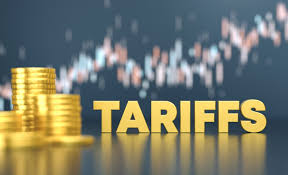GS III-Economy

Context:
Former U.S. President Donald Trump has proposed a new “Liberation Day” tariff regime, introducing a 10% flat import duty and targeted higher tariffs, including a 27% levy on Indian exports, sparking global trade concerns.
What is a Tariff?
A tariff is a form of taxation imposed by a country on imported goods and services, primarily to regulate trade, protect local industries, or generate revenue. These taxes are collected at customs checkpoints when goods enter a country.
Types of Tariffs
- Ad Valorem Tariff:
A percentage-based duty on the value of the goods.
Example: 10% on the value of imported electronics. - Specific Tariff:
A fixed charge per physical unit.
Example: $5 per kilogram of imported sugar. - Compound Tariff:
Combines both ad valorem and specific components.
Example: 5% of the product value + $50 per unit. - Anti-Dumping Duty:
Imposed on goods imported at prices lower than their normal value to protect domestic markets. - Countervailing Duty (CVD):
Levied to offset subsidies provided by exporting countries to their producers. - Reciprocal Tariff:
Introduced in response to tariffs imposed by another country, reflecting retaliatory trade measures.
Rationale Behind Imposing Tariffs
- Safeguard Domestic Industries:
Protect local producers from cheap imports. - Address Trade Deficits:
Reduce excessive reliance on foreign goods and balance the current account. - Revenue Generation:
Acts as a fiscal tool for governments, especially in developing economies with limited tax bases. - Foreign Policy Instrument:
Used in trade negotiations or as an economic sanction tool to influence global diplomacy.
Who Bears the Cost of Tariffs?
- Importers:
Pay tariffs directly upon importing goods. - Consumers:
May experience increased prices as importers pass on tariff costs. - Businesses:
Some may absorb the tariff impact, reducing profit margins or adjusting pricing. - Exporters:
Often reduce their prices to remain competitive, thereby affecting revenue and profitability.
Understanding Reciprocal Tariffs
Reciprocal tariffs are duties imposed by a country in response to equivalent or higher tariffs by a trading partner.
Example: If India applies a 54% import duty on U.S. goods, the U.S. may retaliate with a 27% tariff on Indian exports.
Implications for India
- Export Sectors at Risk:
Industries such as pharmaceuticals, steel, textiles, and electronics may face higher entry barriers in the U.S. market. - Market Diversification Need:
India may explore alternate export destinations to reduce dependency on U.S. markets. - Policy and Diplomatic Response:
Could prompt India to engage in bilateral trade negotiations or seek redressal via multilateral trade forums. - Boost to Local Manufacturing:
Encourages strengthening of domestic value chains and self-reliant production.
Tariffs, while traditionally used to protect domestic interests, often trigger global trade realignments and tensions. India must navigate such challenges through strategic diplomacy, diversification of trade partners, and robust internal economic resilience. The proposed U.S. policy underlines the growing importance of reciprocal trade dynamics in a rapidly evolving geopolitical landscape.




